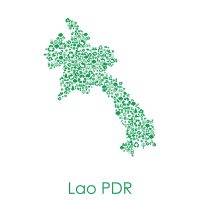1. Development
The surface area of the People's Republic of Laos is 236.800 km2, with a population of 7.3 million inhabitants, 12% of Italy, in a predominantly mountainous territory with a tropical-monsoon climate; Laos is the only country in the Indochinese peninsula without access to the sea.
Among the ten ASEAN countries, it is the one with the lowest nominal GDP and the second to last in terms of nominal GDP per capita, the latter three times lower than the ASEAN average, with an economy based mainly on the export of energy and mineral resources, tourism and subsistence agriculture (the latter represents about 21% of GDP and about 73% of jobs, although in 2020 only 5.5% of the national territory is arable 1).
Laos officially joined the WTO on 2 February 2013 and is currently included in the United Nations list of Least Developed Countries (LDCs), however, in 2021, the good development of the country led the Development Policy Committee to recommend the promotion of Laos with exclusion from the list, a step that should take place between 2024 and 2026, while the Government of Laos believes it is possible to achieve the status of upper-middle-income country by 2030.
The exit from the list of countries with a lower level of development involves the decay of the Preferential Origin of exported goods and the consequent cessation of the favorable customs tariffs granted, therefore the current period is crucial to impress a stable economic growth that is able to drag the development of the country in the transition phase following the loss of privileges.
Lack of adequate infrastructure is often cited as one of the most serious obstacles to socio-economic development in Laos, and so one of the priority objectives of the Lao Government is to push for the upgrading of infrastructure, particularly those that facilitate the development of industries, businesses and society, such as roads, railways, airports, communications systems, electricity and water and sanitation infrastructure, although, in general, capacity constraints limit the provision of infrastructure services outside of major cities in Laos.
The Lao government is particularly interested in turning the apparent disadvantage of being a landlocked country into an advantage by becoming an “interconnected” nation by land, making Laos a connection point between the countries surrounding it (Vietnam, Cambodia, Thailand, Myanmar and China), and acting as a “battery” for the Mekong Sub-Region of the Indochinese Peninsula, thanks to its significant surplus of energy production, especially hydroelectric.
Laos' sustainable development, including the achievement of the 2030 Agenda, depends largely on its ability to transform a capital-intensive and resource-based system into a more diversified economy based on value-added production in manufacturing and services, thus providing remunerative jobs for the young population . This will largely depend on strengthening the private sector, its participation in regional and global value chains, and its attractiveness for Foreign Direct Investment.
Given the structure of the labor force, including the relative scarcity of skilled labor, Laos cannot follow a low-wage development path since its neighbors have a comparative advantage in this regard. Industrial policy will have to be based on higher value-added products and the integration of its production structure into the large regional market.
A comprehensive development strategy will have to emphasize the creation of added value in the agricultural sector, since a large part of the population is still involved in it. Accordingly, the government has defined as its priorities the development of agri-business and the transformation of its natural resources into value-added processed products.
From an environmental and climate point of view, Laos is facing challenges that deeply impact its development, with a deforestation process that has been proceeding at a constant rate since the 1990s and which has brought forest cover from 77.3% of the national territory in 1990 to 71.9% in 2020, with consequent loss of biodiversity and impacts on the management of surface waters, with the increase in flood events.
A very serious and still unsolved problem is the enormous quantity of unexploded bombs scattered throughout the country, resulting from the bombings by the US during the Vietnam War between 1954 and 1975. It is estimated that 270 million bombs were dropped, of which over 2 million were cluster bombs, a figure far greater than the total bombs dropped in the entire Second World War, and that 30% remained unexploded and scattered in unknown locations. Since the end of the war, over 50,000 people have died from the explosion of unexploded ordnance. the director general of the national authority for unexploded ordnance and mines, Chomyaeng Phengthongsavath , said in September 2022 that about 1% of unexploded ordnance is believed to have been cleared since 1996, at this rate, it would take 1,860 years to clear the remaining 99% 2.
Social, environmental and economic sustainability represents a necessary systemic approach for the Laotian government, albeit within the limits of available resources; to prepare for the turning point, therefore, the Laotian government has accelerated the implementation of the necessary reforms, among which stand out:
-
December 18, 2012, Law No. 29/NA (environmental protection)
-
December 26, 2013, Law No. 46/NA (businesses)
-
27 November 2016, Law No. 14/NA (Investment Promotion)
-
December 2018, National Green Growth Strategy
-
June 21, 2019, Law No. 70/NA (Land Law)
-
December 21, 2020, decree n° 624/GOV (Public Private Partnership)
-
March 2021, 9th Five-Year Socio-Economic Development Plan
1https://data.worldbank.org/indicator/AG.LND.AGRI.ZS?locations=LA
2https://theowp.org/the-problem-of-unexploded-ordnance-in-laos/
